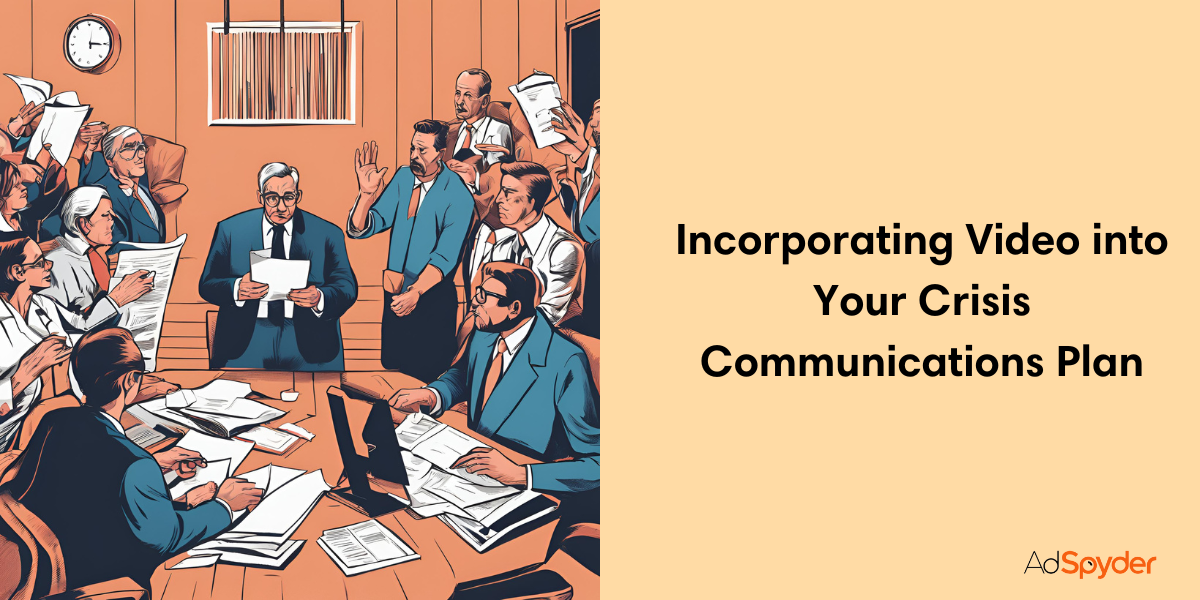Businesses must be prepared to navigate crises that can rapidly escalate and spread online. Whether it’s a product recall, a public relations blunder, or a cyber-attack, how a company manages these crises can make or break its relationship with stakeholders. One of the most effective tools at a company’s disposal during these turbulent times is crisis management with video marketing. Leveraging the power of transparency through video can not only help manage and mitigate the impact of a crisis but also rebuild trust and credibility with the public.
Ready to Elevate your Marketing Strategy?
Summary
- Introduction: The importance of effective crisis communication in the digital age and the unique advantages of video marketing for crisis situations.
- The Power of Video in Crisis Communication: Exploring the benefits of using video to convey sincerity, transparency, and empathy during a crisis.
- Crafting a Compelling Crisis Response Video: Key steps and considerations for creating a video message that resonates with your audience and addresses the crisis effectively.
- Case Studies: Examining real-world examples of companies that successfully utilized video marketing to navigate crisis situations.
- Best Practices for Video Distribution: Effective strategies for disseminating your crisis response video across various channels to reach your target audience.
- Crisis Communication with Video: FAQs: Addressing common questions and concerns regarding utilizing video for crisis management.
- Conclusion: Recap of key takeaways, emphasizing the importance of video in crisis communication, and a call to action.
Why Video Should Be the Number One Tool for Crisis Management With Video Marketing

Video grabs attention and delivers messages quickly during a crisis. It allows companies to show sincerity and action directly to their audience.
Human Connection
Human connection plays a crucial role in crisis management through video marketing. Videos allow for authentic communication, enabling brands to express empathy and connect emotionally with their audience. This direct form of communication can help strengthen consumer trust and build a more resilient brand image during tough times.
Training spokespeople to deliver messages with genuine care and understanding significantly impacts how the audience perceives the message. Successful crisis videos often lead to stronger connections not just with consumers but also among employees, fostering an environment of trust and engagement across all levels of an organization.
Transparency & Accountability
Transparency and accountability stand as pillars of effective crisis management with video marketing. Video allows companies to communicate openly and honestly, showcasing their commitment to clarity and trustworthiness.
- By incorporating voice tone and body language, videos reduce the chance for misunderstandings, conveying messages in a way that written statements cannot match. Training spokespeople to deliver these messages empathetically and authentically underscores a company’s responsibility toward its stakeholders.
- Measuring video delivery success plays a crucial role in maintaining transparency and accountability during crises. It helps organizations target specific audiences more effectively and track engagement, providing insights into how well the message is received.
- Moreover, debriefing sessions that involve analyzing video responses post-crisis are vital for rebuilding confidence in the brand. Through such thorough oversight, companies demonstrate their credibility and reliability, solidifying customer trust moving forward.
The next section explores crafting a compelling crisis response video.
Control the Narrative
Controlling the narrative is key in crisis management, and video serves as a powerful tool to achieve this.
- By creating your message through video, you can guide public perception and counteract any potential misinformation.
- Videos allow companies to present their side of the story directly to the audience, ensuring that their voice is heard loud and clear.
- Through visual storytelling, organizations can shape how the crisis is viewed and understood by stakeholders, effectively steering the conversation in a favorable direction.
- This instant comprehension helps businesses lead with transparency and accountability during critical times when every second counts toward maintaining trust with their audience.
Using videos for crisis communication empowers companies to swiftly manage situations by laying out facts clearly and succinctly preventing misinterpretation right from the start.
Emotional Impact
Videos create a powerful emotional impact, making them essential in crisis management.
- They bring stories to life, allowing companies to show sincerity and concern directly. This visual storytelling can influence viewers’ feelings more intensely than text or audio alone.
- Effective communication through video also helps build trust by showing the audience real people behind the brand who understand and care about the situation.
- Training spokespeople for empathetic delivery ensures that this emotional impact is positive and genuine.
- By considering the target audience and crafting messages that resonate on a personal level, videos make complex situations relatable.
Viewers feel understood and valued when they see their concerns addressed by genuine individuals rather than faceless entities, enhancing engagement with the message being conveyed.
Crafting a Compelling Crisis Response Video

Creating a powerful crisis response video can turn the tide in your favor by directly speaking to your audience’s concerns and emotions.
Acknowledge the Crisis Management With Video Marketing
Immediately addressing the crisis head-on shows transparency and builds trust with your audience. Business leaders must openly recognize there is a problem, setting the stage for genuine communication.
- This approach demonstrates responsibility and underscores the importance of crisis planning that nearly 7 in 10 business leaders have recognized as crucial over a five-year period.
- Crafting an emergency response video begins with this acknowledgment. It signals to viewers that you are aware of the situation and are taking steps to address it. A key message delivered early helps break through distractions and connects directly with your audience, making compelling storytelling possible from the outset.
- Promote these videos in channels such as Instagram ads, LinkedIn ads, and others to make sure it is viewed by most people who are following you in these channels.
This tactic is foundational in effective crisis communication strategies, ensuring your message resonates deeply with those watching.
Express Empathy
After acknowledging the crisis, it’s crucial to express empathy in your video. Empathy builds a bridge between you and your audience, showing them you understand and share their feelings.
- It’s about connecting on a human level, demonstrating compassion and support for those affected by the crisis.
- Empathy is seeing with the eyes of another, listening with the ears of another, and feeling with the heart of another.
- Your response should sympathize with all involved, making it clear that you grasp the depth of their concerns.
Addressing these emotions directly supports your message’s sincerity, helping to relate more effectively to those watching.
Provide Clear & Concise Information
Moving from expressing empathy, it’s crucial to pivot to providing clear and concise information in your crisis response video. This means directly addressing the situation with factual accuracy and brevity.
- Use simple language that everyone can understand, removing any industry jargon that might cloud your message. Your goal is to convey key points quickly so viewers grasp the essence of your response without getting bogged down by details.
- Crafting engaging content requires focus on effective messaging that cuts through noise and confusion. Ensure every sentence serves a purpose, pushing for audience engagement while maintaining an authentic communication tone.
Viewers appreciate straightforwardness during times of crisis. It helps build trust and demonstrates transparency. By concentrating on these elements, you create compelling storytelling that resonates deeply with your audience, making your video strategy not just seen but felt.
Maintain a Sincere Tone
Crafting a compelling crisis response video demands an authentic tone from start to finish.
- Speakers need to speak with sincerity, ensuring that every word conveys genuine concern and commitment to resolving the issue.
- The use of honest messaging throughout the video helps build trust with your audience. It’s not just about acknowledging the problem; it’s also showing that you deeply understand its impact on people’s lives.
- Employing an empathetic approach is crucial for connecting on a human level. Videos allow viewers to see your empathy through facial expressions, body language, and voice tone, making the emotional appeal stronger.
- Also make sure you are following responsible advertising principles, so that the message is genuine and trustworthy.
A sincere delivery promotes transparency and shows your company’s dedication to making things right, which can significantly enhance the effectiveness of your communication during a crisis.
Call to Action
After ensuring the video maintains a sincere tone, it’s time to move forward with a compelling call to action. A video in crisis management must always push for resolution while demonstrating an urgent appeal for understanding and patience from viewers.
It should guide them on what steps they can take next or how they can stay informed about ongoing updates. Addressing viewer concerns directly, this part of the video reassures them that solutions are being sought and highlights commitment to resolving the issue at hand.
Case Studies: Effective Crisis Management With Video Marketing
Discover how giants like Johnson & Johnson and United Airlines turned crises around using powerful video communication.
Johnson & Johnson’s Tylenol Crisis (1982)
Johnson & Johnson’s swift response to the Tylenol crisis in 1982 set a new benchmark for crisis management. After several people died from consuming cyanide-laced Tylenol capsules, the pharmaceutical company acted quickly.
- They initiated a nationwide recall of Tylenol products, demonstrating their commitment to public safety and consumer protection. This move helped to ensure public health and restored trust in their brand.
- Their communication strategy was transparent and effective, incorporating urgent public notifications about the product contamination.
- By prioritizing customer safety over profit, Johnson & Johnson successfully managed this emergency response situation.
The company’s handling of the crisis is often cited as an exemplary approach in maintaining transparency and accountability during such critical times.
Check this out: Repurposing Content for Video Marketing | Top Strategies for 2025
United Airlines’ Overbooked Passenger Incident (2017)
In 2017, United Airlines faced a public relations crisis after a video went viral showing a passenger being forcibly removed from an overbooked flight. This incident underscored the critical role of crisis communication and how it can significantly impact brand reputation and customer trust.
The company’s response to the situation highlighted the need for quick, transparent, and empathetic communication strategies that address stakeholders’ concerns while preserving the integrity of the corporate image.
Effective crisis management through video marketing emerged as a pivotal tool for United Airlines to address public outrage and begin rebuilding its damaged reputation. By leveraging corporate video communications, businesses like United Airlines have learned valuable lessons in managing crises proactively rather than reactively, demonstrating accountability and commitment to customer satisfaction in challenging times. This moment made clear the power of video in communicating during a crisis.
Chipotle’s Food Safety Issues (2015)
Chipotle faced significant challenges in 2015 due to food safety issues that sparked widespread concern over the restaurant’s hygiene practices. These problems led to a considerable drop in consumer trust and negatively affected the company’s profits and public image. The crisis highlighted the critical need for effective crisis management and communication strategies within businesses, especially those in the food industry where public health is directly at stake.
The brand’s response involved launching a comprehensive plan aimed at addressing the concerns raised by the foodborne illness outbreak, reinforcing their commitment to high standards of food safety, and working diligently to restore customer confidence.
Their efforts showcase how companies can navigate through difficulties by implementing transparent communication and taking decisive action to protect both their consumers and reputation.
Incorporating Video into Your Crisis Communications Plan

Including video in your crisis communications strategy can make your efforts more effective. Videos allow you to directly address concerns and build trust with your audience quickly.
Planning
Planning involves setting clear objectives for your crisis communication strategy. This step is essential as it guides what message to convey, how to deliver it, and who the best spokesperson is to represent your organization.
- Identifying potential challenges early allows you to tailor your video content accordingly, ensuring that your response is both timely and appropriate.
- Training plays a vital role in preparing spokespeople for their moment in front of the camera. Through media training, they learn how to express empathy effectively and deliver messages that resonate with viewers.
A well-prepared spokesperson can significantly impact how your audience perceives the video, emphasizing the importance of selecting someone who can communicate sincerity under pressure. Empathy in delivery transforms crisis messaging into meaningful communication.
Monitoring
After setting up a comprehensive plan for crisis communication, the next crucial step is monitoring. This involves keeping an eye on media coverage to gauge the effectiveness of video content in conveying key messages during a crisis.
- Monitoring helps identify the audience’s response and engagement with the message, ensuring that it resonates well across different platforms.
- Companies use media monitoring tools to track how their crisis response videos are received by viewers. It provides means of determining the success of their marketing efforts of the crisis response.
- By analyzing data on viewer reactions and feedback, they can adapt their strategy if necessary.
This real-time adaptation is essential for maintaining control over the narrative and ensuring that the intended message reaches the target audience effectively.
Taking action
Taking action involves swiftly implementing your crisis communications plan with a strong focus on video content. Acting quickly helps maintain control over the narrative and ensures that your message reaches the audience before misinformation can spread.
- Ensure each video communicates sincerity, shares factual information, and addresses the crisis tactically to build trust and protect brand reputation.
- Engaging visuals combined with clear, concise messaging reinforce your commitment to transparency and accountability.
- As you execute this phase, monitor public reaction closely. Adjust strategies as needed based on feedback to improve effectiveness and public perception.
- Always aim for prompt response while prioritizing accuracy over speed to enhance trust building among viewers.
Keep in mind that how you respond in a crisis can strengthen employee relations and customer loyalty if handled correctly. After taking decisive steps to manage the situation, it’s crucial to reflect on the outcomes as you move into debriefing.
Debriefing
Debriefing plays a crucial role in the aftermath of a crisis by evaluating the effectiveness of the video communication strategy. Companies analyze how well they communicated with their audience, assess public perception, and examine media relations to identify strengths and weaknesses. This process is vital for refining future emergency responses and improving overall crisis management practices.
JetBlue’s approach to debriefing after their crisis shows how companies can rebuild brand confidence. By acting swiftly on their crisis response plan and utilizing video updates, they demonstrated transparency and accountability.
This helped restore customer confidence and reinforced their employer brand, showcasing a commitment to both passengers and employees alike.
How Corporations Can Utilize Video for Effective Crisis Management With Video Marketing
Corporations can use video to share their side of the story directly with the public, helping them manage crises more effectively.
Building brand awareness
Video marketing serves as a powerful tool for building brand awareness during times of crisis. By crafting engaging and transparent videos, companies can connect with their audience on a personal level, enhancing customer engagement and loyalty.
This visual storytelling approach communicates the brand’s values and illustrates its commitment to transparency and accountability.
Employing video content strategically strengthens public perception and fosters brand recognition. It allows corporations to manage their reputation effectively by addressing issues directly, thus reinforcing trust among consumers and employees alike.
Videos provide a platform for companies to share their crisis response efforts in an accessible manner, which in turn supports the corporate image by demonstrating responsibility and empathy.
Managing reputation
Managing reputation through video during a crisis shows the public that a company is aware of the situation and actively working to resolve it. Videos enable this by offering a platform for direct communication, where firms can express empathy, acknowledge issues, and share steps they’re taking for resolution.
This approach helps in maintaining or even improving the brand image in the eyes of consumers, as it demonstrates transparency and accountability.
Corporations monitor media coverage keenly and adapt their video strategy promptly to ensure messages resonate well with their audience. By engaging viewers with effective messaging and fostering audience engagement, companies work on preserving a positive public perception throughout the crisis.
This method proves crucial in stabilizing and enhancing brand image during challenging times, making video an indispensable tool in any crisis communication strategy.
Responding to crises
Corporations can use video as a powerful tool to respond to crises quickly and effectively. By creating response videos, companies can address issues head-on, showing their commitment to resolving the situation.
Videos allow for a more human connection, offering transparency and accountability that written statements often lack. This approach lets businesses control the narrative, ensuring their side of the story is heard.
Using visual storytelling in crisis communication helps reduce misinterpretation since visual information is processed vastly faster than text—60,000 times faster according to research.
Companies that incorporate video into their crisis management strategies can communicate their messages more clearly and efficiently. This method manages reputations and aids in rebuilding trust with the audience by offering immediate and direct responses through an accessible medium.
Tips for Using Video in Crisis Management With Video Marketing
To handle a crisis effectively with video, it’s crucial to pick the right medium that reaches your audience fastest. Carefully planning your message ensures clarity and helps maintain calm during tough times.
Choose the right medium
Selecting the right medium is crucial in crisis management. Technology makes it easier to produce and distribute videos through platforms like Skype, Zoom, and social media, allowing for a wide reach. The choice between pre-recorded messages, live streaming, or video conferencing depends on the message’s urgency and the audience’s needs. Opting for social media platforms can offer real-time engagement with the audience, while a detailed response might be better suited for online videos where length isn’t as constrained.
Planning your message carefully is essential after finding the perfect medium.
Plan your message carefully
Planning your message carefully is key in crisis communication. A well-thought-out video strategy ensures that the key messages resonate with the audience effectively during a crisis.
This involves being sincere, factual, and tactful to maintain trust and authenticity with your viewers. Crafting each word with precision allows for clear and impactful delivery of your message, ensuring it aligns with the emotional state and needs of your audience.
It’s crucial to embed empathy, transparency, and relevance in your communication strategy. By doing so, you engage the audience on a deeper level, fostering connection through visual storytelling.
Your message should directly address their concerns while providing clear guidance or solutions related to the crisis at hand. This approach demonstrates care and strengthens brand reputation amid challenging circumstances by placing emphasis on community well-being over corporate interests.
Consider the tone and style
Choosing the right tone and style for your crisis response video is like picking the right outfit for an important event. It must fit well, feel appropriate, and convey the right message. The tone you select should reflect empathy, authenticity, and sincerity. These qualities ensure that your audience perceives your message as genuine. Training spokespeople to deliver messages with emotional intelligence also plays a critical role.
Their ability to communicate nonverbally through voice tone and body language can significantly influence how the audience receives and interprets your video content.
Crafting your video with these elements in mind helps build trust with your viewers during a crisis. Keep each statement clear and direct to avoid misunderstandings, ensuring that the emotion behind every word aligns with the situation at hand.
This careful consideration will help in managing public relations effectively and aids in fostering a more human connection between you and your audience. Now let’s address how best to communicate directly to audiences’ concerns through video messaging.
Address the audience’s concerns
Listening and responding to the audience’s concerns is vital in crisis management. Personal messages through video can show care for customers, investors, and employees, highlighting authenticity and empathy.
It is crucial to acknowledge the problem directly and offer clear solutions. This approach reassures your audience that their worries are heard and addressed effectively. Engaging with your audience during a crisis builds trust and aids in conflict resolution. Transparency in communication fosters a sense of reliability among viewers, making them feel valued.
By demonstrating an understanding of their concerns, you solidify the relationship between your brand and its stakeholders, paving the way for successful crisis resolution through effective public relations strategies.
Choosing the right spokesperson
Selecting the right spokesperson is a crucial step in crisis management. This person should have strong communication skills and be capable of delivering messages with empathy and confidence. They need media training to handle press questions effectively and maintain control over the narrative. A spokesperson reflects your organization’s values, so their authenticity and ability to connect on a human level can significantly impact the audience’s perception.
The chosen individual must also understand the nuances of crisis communication strategy to ensure that every message conveyed aligns with the overall goals of reputation management.
Their role goes beyond mere delivery; they engage in active listening, adapt to feedback, and guide the organization through turbulent times with strategic messaging.
Being concise and considering tone
Crafting videos for crisis management requires being brief and clear while also mindful of the tone. Every word counts, aiming to convey your message quickly without losing the audience’s interest. A respectful and authentic tone assures viewers that you understand the gravity of the situation and are committed to resolving it. Keep your language simple, direct, and free from industry jargon to ensure that your intended message is easily understood by everyone.
Learn from it
Make sure your crisis communication is noted and archived for future uses. Implement changes to your video content calendar using these learnings. Make sure the steps mentioned or promised in the crisis response videos are implemented earnestly.
Ensuring videos are sincere, factual, and tactful adds a human element crucial in times of crisis. Voice tone and body language should align with the gravity of the situation, demonstrating empathy towards affected parties. This approach not only builds trust but also strengthens relationships with your audience during challenging times. Now we will discuss best practices for video distribution.
Best Practices for Video Distribution
Spreading your video effectively ensures it reaches the right audience at the crucial time. Select platforms that align with where your viewers spend most of their online moments for maximum impact.
Website
Your website serves as the cornerstone for distributing crisis management videos To ensure effective crisis communication through video marketing, emphasize hosting your video on a platform that allows easy access and sharing. The website should highlight best practices for video distribution channels, offering practical tips to navigate through crisis situations efficiently.
Engaging with your audience via a well-structured website can significantly enhance your company’s ability to manage its reputation during crises.
Social Media Platforms
Moving on from website distribution, social media platforms offer a crucial avenue for spreading your crisis communication videos. Twitter, YouTube, Facebook, and Instagram have become pivotal in shaping public opinion during a crisis. By utilizing these online platforms, you can quickly disseminate video content to a wide audience. This approach ensures broad visibility and facilitates immediate engagement with viewers.
Social media enhances the ability to share important updates swiftly and allows for real-time feedback from the audience. With digital technology advancements, platforms like Skype and Zoom further support video production and distribution efforts.
Through strategic use of social media channels, companies can efficiently manage their online presence and handle crisis situations by maintaining open lines of communication with stakeholders.
Press Releases & Media Outreach
Crafting engaging press releases and focusing on strong media outreach are key steps in distributing your crisis response videos. Press statements that include your video content give journalists and media outlets the exact narrative you want to share, ensuring consistency across stories.
By doing so, you extend your reach far beyond your immediate network, tapping into new audiences through trusted news sources.
Effective media relations also play a crucial role in crisis management. Training spokespersons to deliver messages empathetically and genuinely can make a significant difference in public perception.
Strategizing distribution ensures that your video reaches a broad and appropriate audience. These tactics combined help maintain control over the narrative during times of crisis, making press releases and media outreach invaluable tools in any communication strategy.
Email Marketing
Email marketing serves as a pivotal channel for distributing videos during crisis situations. It provides a direct line to consumers and employees, enhancing the personal connection and ensuring your message is received promptly.
By incorporating video into your emails, you engage with your audience more effectively, delivering transparent messages that can convey empathy and detailed information swiftly. This approach fosters trust and bolsters your communication strategy during critical times.
Crafting personalized email campaigns allows organizations to target specific segments of their audience with customized video content. These segmented emails can address concerns unique to each group, making the communication feel more relevant and engaging.
Proper use of email marketing supports a comprehensive crisis management plan by strengthening consumer engagement through well-crafted and distributed video messages.
Paid Advertising
Paid advertising plays a vital role in getting your crisis response videos in front of the right audience at the right time. Using sponsored content and promoted videos across various platforms can significantly boost visibility. This approach ensures that your message does not get lost in the sea of online content. By strategically placing paid media, companies can directly address issues, manage their reputation effectively, and communicate crucial information during crises.
Selecting appropriate channels for paid advertising requires understanding where your audience spends most of their time online. Whether it’s social media platforms, search engines, or other digital spaces, targeted ads help ensure that your video marketing reaches those who need to see it most.
FAQs
Video allows direct, transparent communication, building trust by showing sincerity and accountability.
It lets brands deliver their message directly, minimizing misinformation and steering public perception.
Empathy fosters connection, showing the audience you care about their concerns.
Acknowledge the issue, express empathy, provide clear information, and maintain a sincere tone.
Use platforms like social media, websites, and press releases for broad visibility.
Trained spokespeople deliver messages with authenticity, enhancing trust.
It ensures openness and clarity, reinforcing the brand’s credibility.
Conclusion
Recap
Video has proven itself as an indispensable tool in crisis management, showing a unique ability to convey human emotions and establish connections that written communication often lacks.
Keep the audience engaged. Provide clear and concise information during a crisis. 45% of business leaders have a documented plans that include video for managing crises. It’s evident how vital this medium has become.
Final Thoughts
Using video for crisis management transforms challenges into opportunities for connection and trust-building. Companies can swiftly address concerns, showcasing their commitment to transparency and empathy. This powerful approach helps manage the current situation and strengthens the brand for future growth. By embracing video in crisis communications, businesses demonstrate leadership and dedication to their customers and community.
Engaging in this strategy ensures a resilient reputation, ready to face any challenge with confidence and clarity.
Call to Action
Is your company prepared to handle a crisis? Here are some actionable steps:
- Develop a Crisis Communication Plan: Outline your video strategy. Designate a point person for video communication, and establish clear distribution channels.
- Invest in Video Production Training: Equip your team with the skills to create compelling and effective video messages.
- Practice Makes Perfect: Conduct mock crisis scenarios to practice your video communication skills and refine your approach.
Take these proactive steps to ensure that your company is well-equipped to leverage video marketing. It is a powerful tool for crisis communication. Remember, in a crisis, clear, transparent, and empathetic communication is key. Video, when used thoughtfully and strategically, can be your ally in navigating difficult situations and emerging stronger on the other side.




